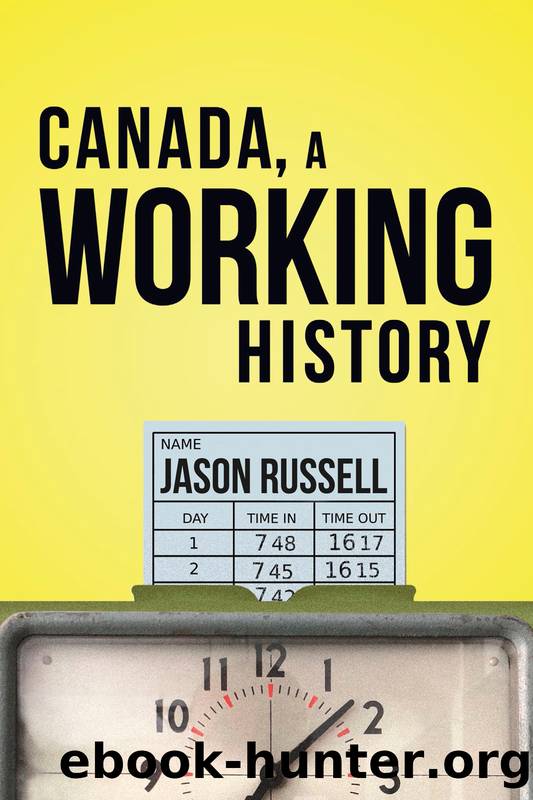Canada, a Working History by Jason Russell

Author:Jason Russell [Russell, Jason]
Language: eng
Format: epub
Tags: HISTORY / Social History
ISBN: 9781459746046
Publisher: Dundurn Press
Published: 2021-03-23T00:00:00+00:00
23 THE 1980s: ALMOST EVERYTHING CHANGES
In Canada, the 1980s brought some key departures from the 1970s. The decade started off with a Liberal government, but almost halfway through was replaced by a Conservative administration. The economy became less regulated and more unequal in terms of who benefited from growth and who did not. Technological transformation accelerated during the decade, especially as computers became more ubiquitous in all workplaces. The change in immigration policy introduced by the Liberal government in the early 1970s had a substantial impact on the demographics of the Canadian workforce. Canada started admitting more immigrants from Asia, and migration levels from Europe decreased. Canadians liked to think their country mattered on the international stage, and the decade ended with a major shift in international relations. It was a decade of both soaring optimism and deep cynicism for all workers.
Electoral politics in the 1980s commenced in ways similar to the previous decade. The rather feckless Conservative minority government led by Joe Clark lasted six months in 1979 before it was brought down on a non-confidence motion moved by NDP MP Bob Rae. Pierre Trudeau did not signal if he was going to definitively say he was staying on as Liberal leader after the 1979 election but still chose to lead his party into the 1980 contest. He won another majority government and dealt with two landmark events in Canadian political history, both of which had repercussions for work and labour.
The Parti Québécois government held a sovereignty referendum in 1980. Uncertainty about Quebecâs future with Canada had a negative economic impact, since businesses were understandably concerned about what it could mean to invest money anywhere in a country that might eventually be split apart. Quebecâs unemployment rate was often higher than in neighbouring Ontario, although the PQ introduced better legal protections for unionized workers, including a ban on the use of replacement workers during strikes. The PQ lost the referendum, with 40 percent of voters supporting sovereignty and 60 percent against it.
The sovereignty movement was poorly understood in English Canada, but the PQ also did not understand English Canada. The PQ talked about âsovereigntyâ and English Canadians heard âseparatism.â The fact that Quebec was governed by a party that wanted a different relationship with English Canada did not prevent the provinceâs economy from growing. It also turned out that the exodus of anglophone companies in the 1970s did not necessarily impair business growth. Québecor, a major media conglomerate extolled as an example of a significant business in the province, was owned by Pierre Péladeau, who was also a PQ supporter.
The PQ pursued interventionist economic policies, with the government playing an important role as an investor and employer. Hydro-Québec was owned by the provincial government and was regarded as a shining example of what the Québécois could accomplish without the assistance or interference of English Canada. The fact that Hydro-Québecâs electric-generating projects had serious environmental impacts and damaged the livelihoods of Cree communities was not factored into the business equation.
Download
This site does not store any files on its server. We only index and link to content provided by other sites. Please contact the content providers to delete copyright contents if any and email us, we'll remove relevant links or contents immediately.
International Integration of the Brazilian Economy by Elias C. Grivoyannis(90822)
The Radium Girls by Kate Moore(11921)
Turbulence by E. J. Noyes(7935)
Nudge - Improving Decisions about Health, Wealth, and Happiness by Thaler Sunstein(7615)
The Black Swan by Nassim Nicholas Taleb(7010)
Rich Dad Poor Dad by Robert T. Kiyosaki(6399)
Pioneering Portfolio Management by David F. Swensen(6226)
Man-made Catastrophes and Risk Information Concealment by Dmitry Chernov & Didier Sornette(5921)
Zero to One by Peter Thiel(5685)
Secrecy World by Jake Bernstein(4643)
Millionaire: The Philanderer, Gambler, and Duelist Who Invented Modern Finance by Janet Gleeson(4374)
The Age of Surveillance Capitalism by Shoshana Zuboff(4209)
Skin in the Game by Nassim Nicholas Taleb(4161)
Bullshit Jobs by David Graeber(4094)
The Money Culture by Michael Lewis(4076)
Skin in the Game: Hidden Asymmetries in Daily Life by Nassim Nicholas Taleb(3929)
The Dhandho Investor by Mohnish Pabrai(3698)
The Wisdom of Finance by Mihir Desai(3650)
Blockchain Basics by Daniel Drescher(3506)
